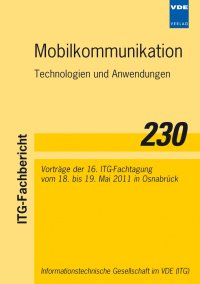Performance of a Heuristic Uplink Radio Resource Assignment Algorithm for LTE-Advanced
Conference: Mobilkommunikation 2011 - Technologien und Anwendungen - 16. ITG-Fachtagung
05/18/2011 - 05/19/2011 at Osnabrück, Deutschland
Proceedings: Mobilkommunikation 2011
Pages: 6Language: englishTyp: PDF
Personal VDE Members are entitled to a 10% discount on this title
Authors:
Garcia Luna, Jairo Alfonso; Mühleisen, Maciej; Henzel, Kay (ComNets Research Group, Faculty 6, RWTH Aachen University, Germany)
Abstract:
LTE-Advanced (LTE-A) proposed by the 3rd Generation Partnership Project (3GPP) has been accepted by the International Telecommunication Union (ITU) in 2010 as an IMT-Advanced (IMT-A) compliant fourth generation (4G) mobile radio system. As a candidate system it had to prove its performance in terms of cell spectral efficiency, cell edge user spectral efficiency and Voice over IP (VoIP) capacity in predefined scenarios. One of these scenarios is the so called "Indoor Hotspot" scenario modelling a femto- or picocell deployment where base stations cover a relatively small area but operate in very close proximity. Interference mitigation and radio resource management in such deployments are challenging tasks. In this work we evaluate the optimal radio resource allocation with focus on maximising the overall system spectral efficiency by scheduling adequate user terminals in the same resources. The results are compared to a proposed heuristic radio resource assignment algorithm as well as to an unoptimised random resource assignment. In addition, the computational effort of all three algorithms is compared to determine their practical application. The influence of the signal to noise and interference ratio (SINR) to data rate mapping used as input for the presented resource assignment algorithms is also evaluated.


